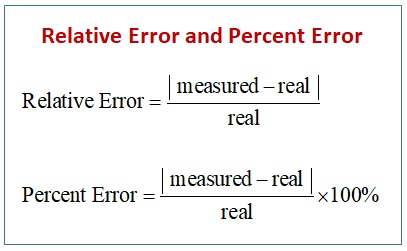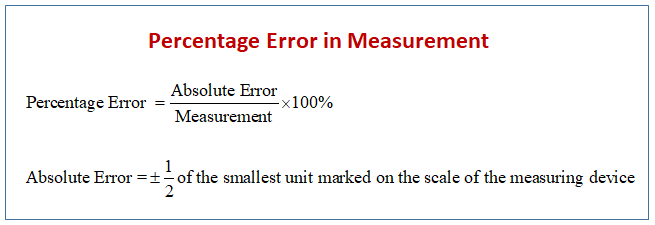Relative And Percent Error Formula
Related Pages
Percent Error
Percent Error Problems
Lessons for High School Regents Exam
In these lessons, we look into Relative Error and Percent Error as required in the Regents Exam conducted by NYSED.
The relative error is a way to express the error in a measurement or calculation relative to the size of the true or accepted value. It’s often more useful than the absolute error because it gives you a sense of the error’s significance.
Relative error is the amount of error your measurement contains when compared to the total measurement.
The following diagram shows the formula for relative error and percent error. Scroll down the page for more examples and solutions on using the relative error and percent error formula.

Here’s the formula and how to use it:
Formula:
Relative Error = |(Measured Value - Actual (Real) Value)| / |Actual (Real) Value|
Where:
Measured Value: The value you obtained through measurement or calculation.
Actual Value: The true or accepted value (sometimes called the theoretical or exact value).
The vertical bars | | represent absolute value, meaning you always take the positive value of the difference.
Often, the relative error is expressed as a percentage by multiplying the result by 100:
Percentage Relative Error = (|Measured Value - Actual Value| / |Actual Value|) × 100%
Relative Error And Percent Error
To calculate relative error, subtract the measured value by the real value and then divide the absolute of that number by the real value to get the relative error. We can then multiply by 100% to get the percent error.
Percent Error In Measurement
Percentage error is the absolute error divided by the measurement multiply by 100%.
The following diagram shows the formula for percentage error in measurement. Scroll down the page for more examples and solutions on using the percentage error formula.

The absolute error is an accuracy that is ±1/2 of the smallest unit marked on the scale of the measuring device.
Why is Relative Error Useful?
The relative error is useful because it puts the error into context.
An absolute error of 1 cm might be significant if you’re measuring a small object like a pen, but it’s much less significant if you’re measuring a large object like a building.
The relative error tells you how large the error is compared to the size of the thing you’re measuring.
Example Illustrating the Importance of Relative Error:
Measurement 1: Measured length of a pen: 10 cm, Actual length: 9 cm. Absolute error: 1 cm, Relative error: 1/9 ≈ 11.1%
Measurement 2: Measured length of a building: 100 m, Actual length: 99 m. Absolute error: 1 m, Relative error: 1/99 ≈ 1.01%
Even though the absolute error is larger in the building measurement (1 m vs. 1 cm), the relative error is much smaller. The measurement of the building is much more precise in terms of the relative error.
Try out our new and fun Fraction Concoction Game.
Add and subtract fractions to make exciting fraction concoctions following a recipe. There are four levels of difficulty: Easy, medium, hard and insane. Practice the basics of fraction addition and subtraction or challenge yourself with the insane level.

We welcome your feedback, comments and questions about this site or page. Please submit your feedback or enquiries via our Feedback page.